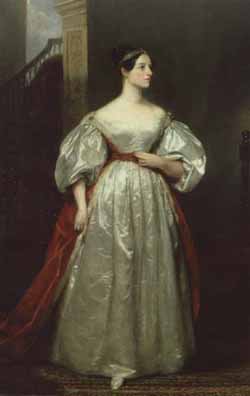The wondrous machine that might have changed the world!
In the Airship Technology Speech I gave back in January at the Absinthe Cafe the place where our Role Playing World separated from the real world was when Babbage's Analytical engine was actually constructed and working in 1880.
This world changing event was due to the work of Augusta Ada King, Countess Lovelace.
In the real world Ada died in November of 1852 before Charles Babbage had perfected his design. In our alternate world she outlived Babbage and was responsible for making his designs work, under contract to the Royal Navy for whom Babbage was working as well.
The Honerable Augusta Ada Byron was the only legitimate daughter of Lord Byron. She married Baron William King in 1835 and when he became the Earl of Lovelace in 1838 she became a countess. Her fascination with mathematics and science as well as what she called "poetical science", describing herself as an "Analyst (& Metaphysician)",brought her into contact with Charles Babbage.
Of her work with Babbage on his Analytical Engine she said:
[The Analytical Engine] might act upon other things besides number, were objects found whose mutual fundamental relations could be expressed by those of the abstract science of operations, and which should be also susceptible of adaptations to the action of the operating notation and mechanism of the engine...
Supposing, for instance, that the fundamental relations of pitched sounds in the science of harmony and of musical composition were susceptible of such expression and adaptations, the engine might compose elaborate and scientific pieces of music of any degree of complexity or extent.
You can read more details of the Countess' work with Charles Babbage on her Wikipedia page.
From the Wikipedia article:
During a nine-month period in 1842–43, Ada translated Italian mathematician Luigi Menabrea's memoir on Babbage's newest proposed machine, the Analytical Engine. With the article, she appended a set of notes. Explaining the Analytical Engine's function was a difficult task, as even other scientists did not really grasp the concept and the British establishment was uninterested in it. Ada's notes even had to explain how the Engine differed from the original Difference Engine. Her work was well received at the time; scientist Michael Faraday described himself as a supporter of her writing.
The notes are longer than the memoir itself and include (in Section G), in complete detail, a method for calculating a sequence of Bernoulli numbers with the Engine, which would have run correctly had the Analytical Engine been built (only his Difference Engine has been built, completed in London in 2002). Based on this work, Lovelace is now widely considered the first computer programmer and her method is recognised as the world's first computer program.
The Countess's translation of Menabrea's memoir and her detailed comments are available at Fourmilabs here:
Sketch of

Invented by Charles Babbage
By L. F. MENABREA
of Turin, Officer of the Military Engineers
from the Bibliothèque Universelle de Genève, October, 1842,
No. 82
With notes upon the Memoir by the Translator
ADA AUGUSTA, COUNTESS OF LOVELACE
ADA AUGUSTA, COUNTESS OF LOVELACE
A truly fascinating look into what could have been a major turning point in world history.
As the author of the Fourmilab web page says:
“Sketch of the Analytical Engine” by L. F. Menabrea, translated and with extensive commentary by Ada Augusta, Countess of Lovelace. This 1842 document is the definitive exposition of the Analytical Engine, which described many aspects of computer architecture and programming more than a hundred years before they were “discovered” in the twentieth century. If you have ever doubted, even for a nanosecond, that Lady Ada was, indeed, the First Hacker, perusal of this document will demonstrate her primacy beyond a shadow of a doubt.
Indeed!
Keep your sightglass full, your firebox trimmed and your water iced.
KJ
P.S.
A fun bit of information given how the Countess' contributions to mechanical computation were fundamental to the development of the fantastic airship we use in our Role Play check this out from her Wikipedia page:
Ada was often ill, beginning in early childhood. At the age of eight, she experienced headaches that obscured her vision. In June 1829, she was paralyzed after a bout of measles. She was subjected to continuous bed rest for nearly a year, which may have extended her period of disability. By 1831, she was able to walk with crutches. Despite being ill Ada developed her mathematical and technological skills. At age 12, this future "Lady Fairy", as Charles Babbage affectionately called her, decided she wanted to fly. Ada went about the project methodically, thoughtfully, with imagination and passion. Her first step in February 1828, was to construct wings. She investigated different material and sizes. She considered various materials for the wings; paper, oilsilk, wires and feathers. She examined the anatomy of birds to determine the right proportion between the wings and the body. She decided to write a book Flyology illustrating, with plates, some of her findings. She decided what equipment she would need, for example, a compass, to "cut across the country by the most direct road", so that she could surmount mountains, rivers and valleys. Her final step was to integrate steam with the "art of flying".Oh if only the Real World had been less cruel.




